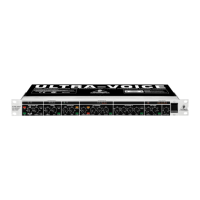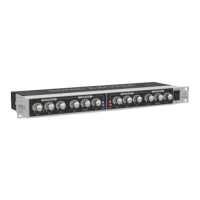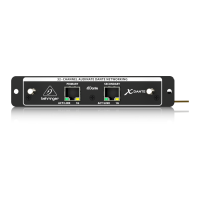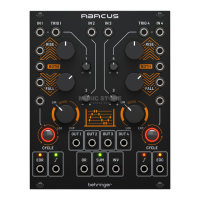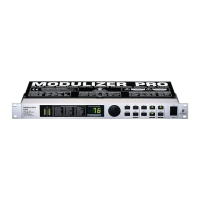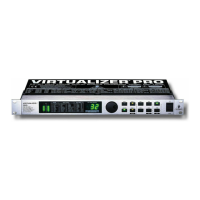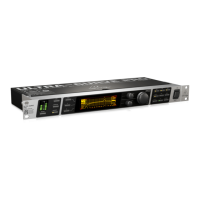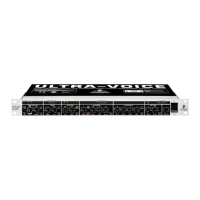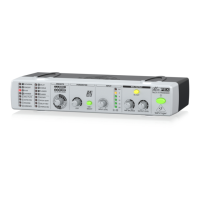26
4.1.4 Expanders/Noise Gates
Audio, in general, is only as good as the source from which it is derived. The dynamic range of signals will often
be restricted by noise. Synthesizers, effects devices, guitar pickups, amplifiers etc. generally produce a high
level of noise, hum or other ambient background hiss, which can disturb the quality of the program material.
Normally these noises are inaudible if the level of the desired signal lies significantly above the level of the
noise. This perception by the ear is based on the masking effect: noise will be masked and thus becomes
inaudible as soon as considerably louder sound signals in the same frequency band are added. Neverthe-
less, the further the level that the desired signal decreases, the more the noise floor becomes a disturbing
factor. Expanders or noise gates offer a solution for this problem: these devices attenuate signals when their
amplitudes drop, thereby fading out the background noise. Relying on this method, gain controlling amplifi-
ers, like expanders, can extend the dynamic range of a signal and are therefore the opposite of a compres-
sor.
In practice, it is shown that an expansion over the entire dynamic range is not desired. With an expansion
ratio of 5:1 and a processed dynamic range of 30 dB, an output dynamic range of 150 dB will be the result,
exceeding all subsequent signal processors, as well as human hearing. Therefore, the amplitude control is
restricted to signals whose levels are below a certain threshold. Signals above this threshold pass through the
unit unchanged. Due to the continuous attenuation of the signals below this threshold, this kind of expansion
is termed downward expansion.
The noise gate is the simplest form of an expander: in contrast to the expander, which continuously attenuates
a signal below the threshold, the noise-gate cuts off the signal abruptly. In most applications this method is not
very useful, since the on/off transition is too drastic. The onset of a simple gate function appears very obvious
and unnatural.
4.2 Denoiser
The noise reduction system of the ULTRAMIZER PRO is based on two signal processing techniques. As
already described a downward expander automatically reduces the overall level for all signals below an
adjustable threshold and therefore reduces the noise in pauses. The second function of the BEHRINGER
Denoiser is based on the masking effect: noise will be masked and thus become inaudible, as soon as
considerably louder sound signals are added.
In the Denoiser function a dynamically controlled low-pass filter is implemented which allows low frequencies
to pass but filters the highs, depending on the music material. In contrast to conventional noise filters with
fixed cut-off frequencies, the BEHRINGER Denoiser shifts the cut-off frequency between 800 Hz and 20kHz,
the exact frequency depending on the program material. This is the range where noise is considered most
annoying. The cut-off frequency of the filter depends both on the input level and the frequency spectrum of
the audio signal.
In simple terms, what this means is that if a signal appears at the input which has primarily bass components,
the dynamic filter will reduce any mid or high-band noise, eliminating any possible breathing side effects. If
the input signal has high frequency components present, the dynamic filter will open to its full extent to pass
the signal and eliminate the possibility of any loss of high frequency response.
4.3 Artificial harmonics generation Exciter
By 1955 an American, Charles D. Lindridge, had already invented the first EXCITER (a unit that EXCITES
upper harmonics), when he presented a unit for improving the sound of music and speech. He enriched
signal sources with artificially generated upper harmonics and found that both sound quality, transparency
and perceived positioning of musical instruments could be considerably improved using this effect. He was
granted an American patent on his circuit design under the number US 2 866 849.
Compared to modern technology, Lindridges circuit was anything but fully developed, however, it featured
many of the aspects found in todays modern circuit designs.
Psycho-acoustic discoveries and greater knowledge, gathered over the years, have allowed for new and
improved circuit designs, through the use of advanced technology.
4. TECHNICAL BACKGROUND
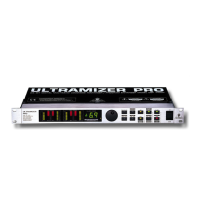
